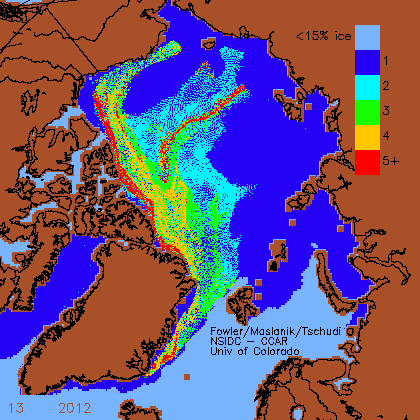Wow, finally I seem to be in with the peak of the distribution.
I've voted between 1 and 2 M km^2, this is what I see as most likely, if I had a second vote it would be 2.234 to 2 M km^2. But I now rate the probabilities as around 75% and 25% respectively, with a probability distribution peaking between 1.75 and 2, and a slim tail extending down towards 1M km^2.
I've voted for that because of the prevalence of FYI. Nightvid Cole has been good enough to let me know that DAM (drift age model) plots are now available up to this year week 13.
ftp://ccar.colorado.edu/pub/tschudi/iceage/gifs/2012 Week 13.

2013 Week 13.

The above images show that this year's pack is far more dominated by FYI than was last year at the same time. This is significant in terms of the melt pattern last year, where as with 2010, the effect of the older ice in the Siberian sector could be seen in the overall melt pattern. As seen in DAM for 2012 week 30:

And Bremen satellite images of the same period.
http://www.iup.uni-bremen.de:8084/ssmisdata/asi_daygrid_swath/n6250/2012/aug/asi-SSMIS-n6250-20120801-v5_visual.pngThe area of persistent low concentration sea ice was, in my opinion, due to the scattered presence of MYI within that region.
This year there will be no such retarding of ice melt due to MYI, the central pack of MYI will not spread, as shown by 2012's spread:
2012 Week 1.

2012 Week 30.

Basically sea ice doesn't move fast enough for such a spread this year, looking at other years supports this contention, in my opinion. Therefore the melt will proceed aggressively in the Siberian sector without impedance due to older ice, which will largely remain an issue in Beaufort.
But I still maintain that under 1M km^2 extent is impossible, and think that under 1M km^2 CT area is very unlikely.
